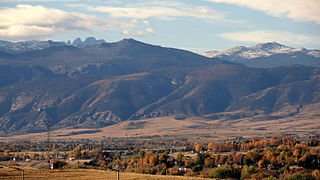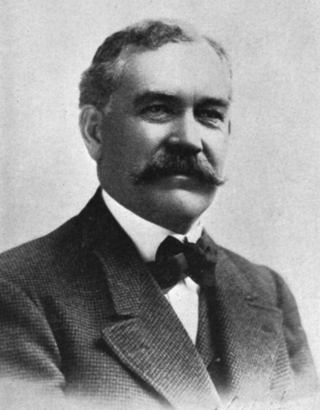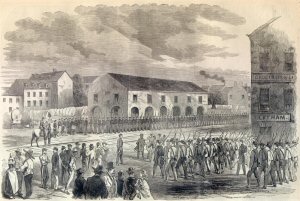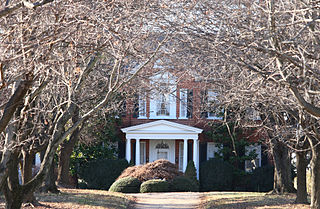Related Research Articles

Sheridan County is a county located in the U.S. state of North Dakota. As of the 2020 census, the population was 1,265, making it the third-least populous county in North Dakota. Its county seat is McClusky.

The City of Sheridan is a home rule municipality located in Arapahoe County, Colorado, United States. Sheridan is a part of the Denver–Aurora–Lakewood, CO Metropolitan Statistical Area. The population was 6,105 at the 2020 census.

Sheridan is a city in Yamhill County, Oregon, United States. Platted in the 1860s when it received a post office, the city was incorporated in 1880. A major fire burned much of the city in 1913, and a flood covered much of the city in 1964. The population of the city as of the 2020 Census was 6,233, an increase from 6,127 at the 2010 census.

Sheridan is a city in the U.S. state of Wyoming and the county seat of Sheridan County. The city is located halfway between Yellowstone Park and Mount Rushmore by U.S. Route 14 and 16. It is the principal town of the Sheridan, Wyoming, Micropolitan Statistical Area which encompasses all of Sheridan County. The 2020 census put the city's population at 18,737, making it the 6th most populous city in Wyoming.

Philip Henry Sheridan was a career United States Army officer and a Union general in the American Civil War. His career was noted for his rapid rise to major general and his close association with General-in-chief Ulysses S. Grant, who transferred Sheridan from command of an infantry division in the Western Theater to lead the Cavalry Corps of the Army of the Potomac in the East. In 1864, he defeated Confederate forces under General Jubal Early in the Shenandoah Valley and his destruction of the economic infrastructure of the Valley, called "The Burning" by residents, was one of the first uses of scorched-earth tactics in the war. In 1865, his cavalry pursued Gen. Robert E. Lee and was instrumental in forcing his surrender at Appomattox Courthouse.
The Army of the Shenandoah was a field army of the Union Army active during the American Civil War. First organized as the Department of the Shenandoah in 1861 and then disbanded in early 1862, the army became most effective after its recreation on August 1, 1864 under the command of Philip Sheridan. The army's actions during the Valley campaigns of 1864 rendered the Shenandoah Valley of Virginia unable to produce foodstuffs for the Confederate States Army, a condition which would hasten the conclusion of the American Civil War.

The Valley campaigns of 1864 began as operations initiated by Union Lieutenant General Ulysses S. Grant and resulting battles that took place in the Shenandoah Valley of Virginia during the American Civil War from May to October 1864. Some military historians divide this period into three separate campaigns. This article considers them together, as the campaigns interacted and built upon one another.

The Rifleman is an American Western television series starring Chuck Connors as rancher Lucas McCain and Johnny Crawford as his son Mark McCain. It was set in the 1880s in the fictional town of North Fork, New Mexico Territory. The show was filmed in black and white, in half-hour episodes. The Rifleman aired on ABC from September 30, 1958, to April 8, 1963, as a production of Four Star Television. It was one of the first primetime series on US television to show a single parent raising a child.

George Washington Thornton Beck was a politician and business entrepreneur in the U.S. state of Wyoming.

William W. Wells, Jr. was a businessman, politician, and general in the Union Army during the American Civil War who received a Medal of Honor for gallantry at the Battle of Gettysburg.

The city of Winchester, Virginia, and the surrounding area, were the site of numerous battles during the American Civil War, as contending armies strove to control the lower Shenandoah Valley. Winchester changed hands more often than any other Confederate city.

Richwood Hall, also known as Richwoods, is a house near Charles Town, West Virginia. The lands once belonged to George Washington, who received them from Thomas Fairfax, 6th Lord Fairfax of Cameron and subsequently gave to his brother, Samuel Washington. It was Samuel's son, Lawrence Augustine Washington, who built or moved into the house with his bride, Mary Dorcas Wood, in 1797. This original house now forms a wing of the present enlarged house. The Washingtons lived at Richwoods until 1802, when they sold the property to Smith Slaughter. By 1829 the house had been enlarged, either by Slaughter or his successor, Joseph Shewater. In any case, materials, including bricks and carved wood were imported from England.

General Philip Sheridan is a bronze sculpture that honors Civil War general Philip Sheridan. The monument was sculpted by Gutzon Borglum, best known for his design of Mount Rushmore. Dedicated in 1908, dignitaries in attendance at the unveiling ceremony included President Theodore Roosevelt, members of the President's cabinet, high-ranking military officers and veterans from the Civil War and Spanish–American War. The equestrian statue is located in the center of Sheridan Circle in the Sheridan-Kalorama neighborhood of Washington, D.C. The bronze statue, surrounded by a plaza and park, is one of eighteen Civil War monuments in Washington, D.C., which were collectively listed on the National Register of Historic Places in 1978. The sculpture and surrounding park are owned and maintained by the National Park Service, a federal agency of the Interior Department.

Take Me To Town is a 1953 American Comedy Western film directed by Douglas Sirk and starring Ann Sheridan and Sterling Hayden.

Angelus is an unincorporated community in Sheridan County, Kansas, United States. It is located in Solomon Township, approximately 20 miles southwest of Hoxie. Also, it is located northwest of Grinnell and Interstate 70.
Rix Mills is an unincorporated community in Muskingum County, in the U.S. state of Ohio.

Taylor is a ghost town in King County, in the U.S. state of Washington.
Wilcox is a ghost town in Whitman County, in the U.S. state of Washington. The GNIS classifies it as a populated place.
Randall is a populated place situated in Montgomery County, New York, United States. It is a hamlet in the northeastern part of the Town of Root on New York State Route 5S. Randall has an estimated elevation of 302 feet (92 m) above sea level.

Adell is a ghost town in Sheridan County, Kansas, United States.
References
- ↑ HistoryLink.org- the Free Online Encyclopedia of Washington State History
- ↑ Sheridan Washington
- ↑ "Notable Native American Women" . Retrieved April 20, 2013.
